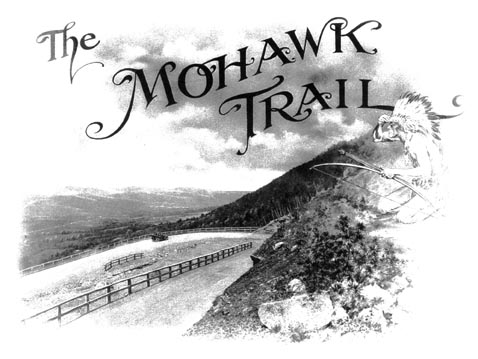 |
| This imagery of the Mohawk Trail was typical during most of the twentieth-century.
Note the automobile on the Hairpin Turn. -- from an Albertype souvenir booklet cover, 1914 |
Da-Pah connected with the owners of Indian Plaza, who were looking for
quality Native goods for their store. Indian Plaza opened in 1933 and carried
a wide array of Native arts from pottery, rugs and jewelry. They invited
him up every summer through the 1940's, where he would work on site. In
addition to jewelry, he constructed a hogan (still standing), and a Yei-ba-chai
sign (1947, no longer standing). In 1938, Da-Pah brought his wife Es-Than-Chi,
a weaver, and his niece Ah-He-Hah-Bah, and her brother, Hus-Ka-De-Yah.
Hus-Ka-De-Yah (also apparently known as Louis) was a singer and hand drummer,
who joined him for many years thereafter.
 |
| Da-Pah, Osa Johnson, and Louis. Osa
Johnson was a famous adventurer
who filmed native wildlife and peoples in Africa and the Pacific islands. Note Da-Pah's silver necklace and belt. Da-Pah is wearing a concha belt, and silver necklace of squash blossoms and at the bottom, a crecent-shaped "nazha" for good luck. -- Artvue postcard, circa 1941 |
He apparently also spent time "in Hartford, Conn. and Boston, Mass. exhibiting and depicting Navajo arts." James Dapah, as he was known in later life, died in 1977 in Continental Divide, New Mexico, where he lived, at the age of 82.
We would be interested to learn more about Da-Pah and Louis. Please contact us at research@ muddyriverpress.com.
 |
| This is one of two scenes that feature a Native group at this tourist
business.
A descendant has informed us that this shows various members of the Tomah family. Further information welcome. -- Anonymous postcard, postmarked 1925 |
For more images of the Mohawk Trail, see the Mohawk Trail Photo Gallery.
Copyright 2007-2008 Muddy River Press. All Rights Reserved.